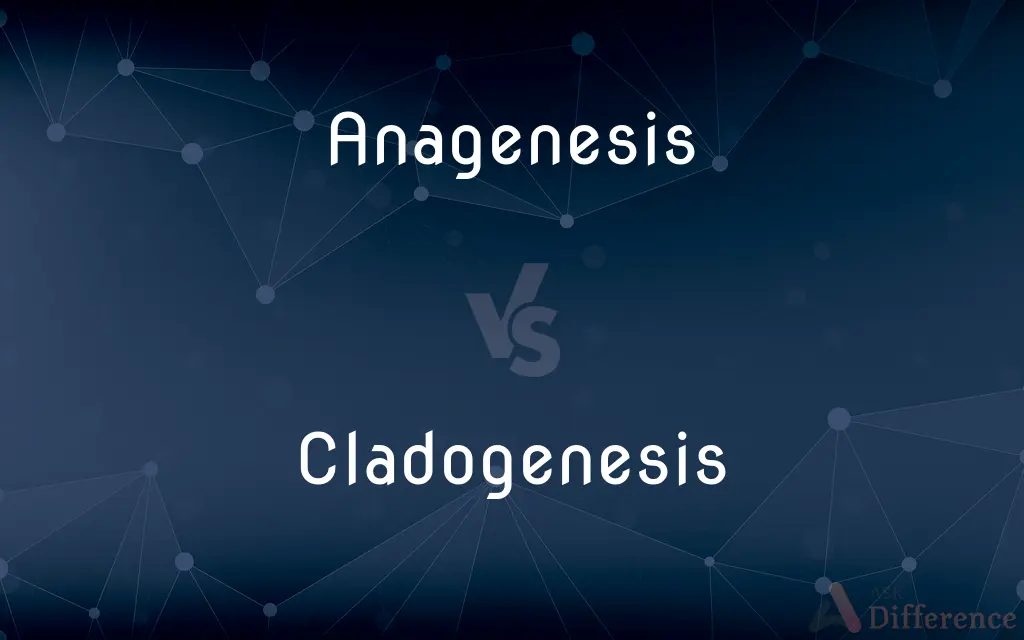Anagenesis vs. Cladogenesis — What's the Difference?
Edited by Tayyaba Rehman — By Urooj Arif — Updated on April 15, 2024
Anagenesis involves species evolution without branching, focusing on gradual changes; cladogenesis, however, results in species divergence and new branches on the tree of life.

Difference Between Anagenesis and Cladogenesis
Table of Contents
ADVERTISEMENT
Key Differences
Anagenesis refers to the evolutionary change within a single lineage where one species evolves into another without creating new branches. This process typically involves gradual transformations over time that do not lead to increased biodiversity. On the other hand, cladogenesis is the process where a species splits into two or more distinct groups, leading to the creation of new species and thus increasing biodiversity.
In anagenesis, the original species can transform to such an extent that it becomes a completely new species, but the lineage remains singular without branching. This type of evolution is often depicted as a straight line on evolutionary diagrams. Whereas cladogenesis involves a branching mechanism, where the ancestral species gives rise to multiple descendant species, commonly depicted as a branching tree.
Anagenesis does not contribute to the biological diversity in an ecosystem as it involves the replacement of one species by another. Meanwhile, cladogenesis significantly contributes to ecological diversity and complexity because it leads to the formation of new species that can exploit different ecological niches.
The mechanisms driving anagenesis and cladogenesis can be influenced by different evolutionary pressures. Anagenesis is typically driven by a steady change in the environment that affects an entire population uniformly. In contrast, cladogenesis often occurs due to a split in the population caused by geographic isolation or ecological specialization.
While anagenesis is considered a simpler form of evolutionary change, focusing primarily on morphological or genetic transformations within a single lineage, cladogenesis is recognized for its role in creating the complex tree of life known today. It introduces complexity and variety through speciation, which is fundamental in evolutionary biology.
ADVERTISEMENT
Comparison Chart
Definition
Evolution within a single lineage without branching.
Evolution that results in the branching of a lineage into two or more distinct species.
Impact on Diversity
Does not increase biological diversity; involves species replacement.
Increases biological diversity by creating new species.
Typical Outcome
A single species evolves into a new form, replacing the original.
Multiple new species emerge, expanding the evolutionary tree.
Drivers
Often uniform environmental changes affecting the whole population.
Often geographic or reproductive isolation leading to speciation.
Depiction
Shown as a straight line in evolutionary diagrams.
Shown as a branching tree in evolutionary diagrams.
Compare with Definitions
Anagenesis
Phyletic evolution.
Anagenesis often involves phyletic changes observable in the fossil record.
Cladogenesis
Branching evolution.
The divergence of apes into humans and other primates is a result of cladogenesis.
Anagenesis
Species transformation without branching.
In anagenesis, a dinosaur species could evolve into another form without creating new species.
Cladogenesis
Contributor to biodiversity.
Cladogenesis is critical for the richness and variety of life on Earth.
Anagenesis
Evolutionary change within a lineage.
The transformation of Eohippus into modern horses is an example of anagenesis.
Cladogenesis
Speciation through divergence.
Cladogenesis often occurs when populations are geographically isolated.
Anagenesis
Single-lineage evolution.
Anagenesis does not result in new species branches but transforms an existing one.
Cladogenesis
Formation of evolutionary trees.
Cladogenesis explains the branching patterns observed in phylogenetic trees.
Anagenesis
Gradual transformation.
Anagenesis demonstrates how species gradually adapt to environmental changes.
Cladogenesis
Multi-lineage evolution.
Cladogenesis leads to multiple descendant species from a common ancestor.
Anagenesis
Anagenesis is the gradual evolution of a species that continues to exist as an interbreeding population. This contrasts with cladogenesis, which occurs when there is branching or splitting, leading to two or more lineages and resulting in separate species.
Cladogenesis
Cladogenesis is an evolutionary splitting of a parent species into two distinct species, forming a clade.This event usually occurs when a few organisms end up in new, often distant areas or when environmental changes cause several extinctions, opening up ecological niches for the survivors and causing population bottlenecks and founder effects changing allele frequencies of diverging populations compared to their ancestral population. The events that cause these species to originally separate from each other over distant areas may still allow both of the species to have equal chances of surviving, reproducing, and even evolving to better suit their environments while still being two distinct species due to subsequent natural selection, mutations and genetic drift.Cladogenesis is in contrast to anagenesis, in which an ancestral species gradually accumulates change, and eventually, when enough is accumulated, the species is sufficiently distinct and different enough from its original starting form that it can be labeled as a new form - a new species.
Anagenesis
An evolutionary process that involves change from an ancestor species to a descendant species without the branching or splitting off of new taxa.
Cladogenesis
An evolutionary process that involves the splitting off or branching of new taxa from an ancestral form.
Anagenesis
The evolution of a new species by the large scale change in gene frequency so that the new species replaces the old rather than branching to produce an additional species.
Cladogenesis
(genetics) An evolutionary splitting event in which each branch and its smaller branches forms a clade
Common Curiosities
Can anagenesis lead to new species?
Yes, anagenesis can lead to the evolution of a new species, but it replaces the ancestral species rather than coexisting with it.
What causes cladogenesis to occur?
Cladogenesis often occurs due to geographic isolation, ecological shifts, or reproductive barriers that split a population into distinct groups.
What is anagenesis?
Anagenesis is evolutionary change within a single lineage that does not involve branching, leading to one species gradually transforming into another.
What is cladogenesis?
Cladogenesis is a type of evolution where one species splits into two or more distinct species, increasing biodiversity.
How does cladogenesis affect an ecosystem?
Cladogenesis affects ecosystems by adding new species, which may lead to new food webs and interactions, enhancing the ecosystem's stability and complexity.
Which type of evolution contributes more to the ecological complexity?
Cladogenesis contributes more to ecological complexity as it introduces new species that can explore different niches.
What are some examples of anagenesis in the fossil record?
Examples of anagenesis include the evolutionary changes seen in the fossil records of horses and some dinosaur species.
Is cladogenesis considered more common than anagenesis?
Yes, cladogenesis is considered more common in nature as it leads to a greater variety of life forms and adaptations.
How do anagenesis and cladogenesis differ in their impact on biodiversity?
Anagenesis does not increase biodiversity as it involves species replacement, while cladogenesis increases biodiversity by creating new species.
Does anagenesis involve genetic changes?
Yes, anagenesis involves genetic changes that accumulate over generations, leading to significant morphological and physiological transformations.
How is anagenesis depicted in evolutionary studies?
Anagenesis is typically depicted as a straight line on evolutionary diagrams, indicating gradual change without branching.
What role does geographic isolation play in cladogenesis?
Geographic isolation is a key factor in cladogenesis as it separates populations, allowing them to evolve independently into new species.
Can environmental changes influence both anagenesis and cladogenesis?
Yes, environmental changes can drive both anagenesis by uniformly affecting a population and cladogenesis by causing splits through isolation.
How do biologists study anagenesis and cladogenesis?
Biologists study these processes through fossil records, genetic analysis, and observing speciation patterns in nature.
Why is understanding both anagenesis and cladogenesis important in evolutionary biology?
Understanding both processes is crucial for comprehending the full spectrum of evolutionary mechanisms and the history of life's diversity.
Share Your Discovery

Previous Comparison
Escortee vs. Escorted
Next Comparison
Late vs. LatestAuthor Spotlight
Written by
Urooj ArifUrooj is a skilled content writer at Ask Difference, known for her exceptional ability to simplify complex topics into engaging and informative content. With a passion for research and a flair for clear, concise writing, she consistently delivers articles that resonate with our diverse audience.
Edited by
Tayyaba RehmanTayyaba Rehman is a distinguished writer, currently serving as a primary contributor to askdifference.com. As a researcher in semantics and etymology, Tayyaba's passion for the complexity of languages and their distinctions has found a perfect home on the platform. Tayyaba delves into the intricacies of language, distinguishing between commonly confused words and phrases, thereby providing clarity for readers worldwide.














































